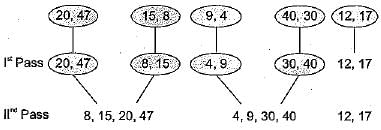Test: Algorithm Analysis & Asymptotic Notation- 3 - Computer Science Engineering (CSE) MCQ
10 Questions MCQ Test - Test: Algorithm Analysis & Asymptotic Notation- 3
Each of the function 2√n and nlogn has a growth rate .... than that of any polynomial.
Time complexity of an algorithm T(n), where n is the input size is given by
T(n) = T( n - 1 ) + 1/n, if n> 1
= 1, otherwise
The order of this algorithm is
T(n) = T( n - 1 ) + 1/n, if n> 1
= 1, otherwise
The order of this algorithm is
The concept of order (Big O) is important because
Consider the following functions:

Which of the following is true?
f(n) = 3n2 + 4n + 2
Which will be the exact value for f(n)?
Which of the following is the average number of key comparisons done by sequential reach in the successful case?
Which sort will operate in quadratic time relative to the number of elements in the array (on the average)?
If one uses straight two-way merge sort algorithm to sort the following elements in ascending order:
20,47,15,8,9,4,40,30,12,17
Then the order of these elements after the 2nd pass of the algorithm is
The recurrence relation:
T(1) = 2
 , has the solution T(n) equal to
, has the solution T(n) equal to
Consider the following two functions:

Which of the following is true?


























